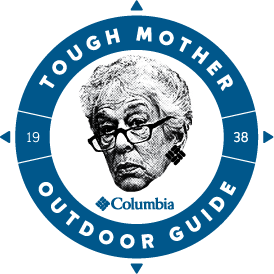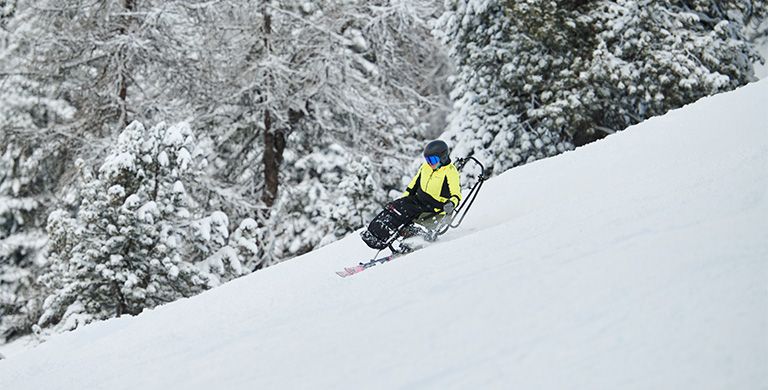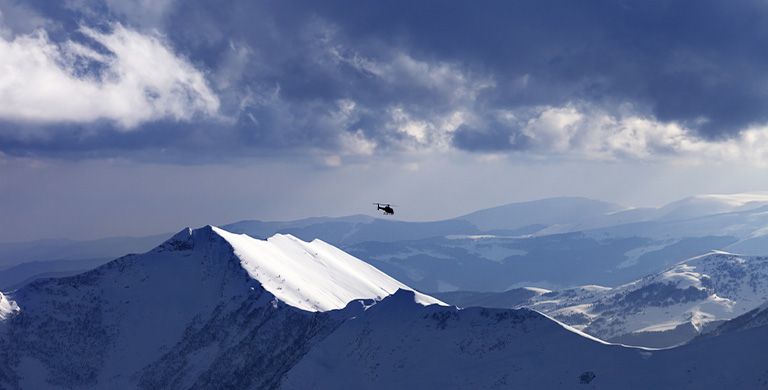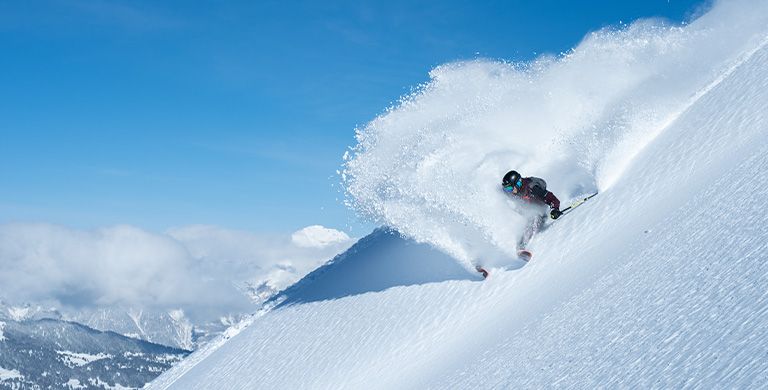SKI & SNOW
Snow, Speed and Thrills: The Action-Packed Sport of Skijoring
Ready for something new? Skijoring is a winter sport for everyone. Here’s what you need to know to join the fun.
BY: NANCY BOUCHARD
Ever wondered what it's like to be towed through a frozen wasteland at breakneck speeds--while strapped to a pair of skis, clinging to whatever sanity you have left? Welcome to skijoring, an adrenaline-soaked marriage of speed and snow. Skijoring—joring may rhyme with boring, but don’t let that fool you—it’s a full-throttle experience where you're pulled as fast as your heart can race. Born from the equestrian roots of horse-drawn madness, skijoring now includes everything from dog teams and horses to high-powered snowmobiles and motorbikes. It’s fast, fun, a bit crazy, and you need no experience to get started—although being comfortable on skis or a snowboard help.

A quick History of Skijoring
Skijoring has a rich history and a wild future. Born over a century ago in Scandinavia, it quickly spread to the Alps and North America, where it became deeply rooted in the rugged terrain of mountain and cowboy culture. While it might sound insane, it’s far from reckless—thanks to SKIJOR USA, a national alliance committed to making the sport safe, sustainable, and community-driven. Their focus ensures that riders, skiers, animals, and machines can push the limits on courses that are designed to be animal friendly and keep you out of the ER. If you like snow, speed, and a bit of chaos, skijoring is definitely worth a try, and it’s a blast to watch.
Winter sports deliver adrenaline in abundance, but a few events kick the thrill into overdrive like skijoring. In St. Moritz, Switzerland, the legendary White Turf ski race dates back to 1907. Skiers, not riders, manage the reins. In Alaska, the Arctic Man race redefines "extreme," as skiers and snowmobilers conquer thousands of feet of vert, reaching 90 mph. Red Bull’s Twitch ‘n Ride, held in Latvia, fuses skiing and motocross in crazy high-speed chase. There are dozens of events and competitions from Maine to California; Steamboat Springs Winter Carnival features skiers of all ages catapulted by horses (and sometimes dogs) over jumps and through gates in the heart of town. In Wyoming, skijoring—blending skiing with cowboy culture—has become the unofficial winter pastime, despite rodeo being the state's official sport. Skijoring Utah has races for everyone from novices to pros, of all ages, with teams like Barley Sober, Ski Ya Later, and Hook, Line, and Snowboarder. And après skijoring parties are pretty much off the rails.
While there’s growing excitement with skijoring competitions that involve horses, skijoring with dogs has a long history. Many people teach their family dogs how to pull for skijoring fun, as it’s a great way to explore the backcountry. As long as a dog is healthy, in good physical shape and full grown, they may enjoy skijoring. Some breeds, like Samoyeds, Alaskan malamutes, and Huskies, are born with the instinct to pull. But other breeds, especially those who love to run, can make great skijoring companions.
Of course, you’ll need the proper ski or snowboarding gear for yourself, and equipment for your horse or dog. Remember, that you’ll heat up while skijoring, so layering is important. You can buy a skijoring belt, elastic skijoring lead and skijoring-specific dog harness, as well as full kits for horses.
We caught up with Loren Zhimanskova, president of SKIJOR USA, to break down the fun.
Winter sports deliver adrenaline in abundance, but a few events kick the thrill into overdrive like skijoring. In St. Moritz, Switzerland, the legendary White Turf ski race dates back to 1907. Skiers, not riders, manage the reins. In Alaska, the Arctic Man race redefines "extreme," as skiers and snowmobilers conquer thousands of feet of vert, reaching 90 mph. Red Bull’s Twitch ‘n Ride, held in Latvia, fuses skiing and motocross in crazy high-speed chase. There are dozens of events and competitions from Maine to California; Steamboat Springs Winter Carnival features skiers of all ages catapulted by horses (and sometimes dogs) over jumps and through gates in the heart of town. In Wyoming, skijoring—blending skiing with cowboy culture—has become the unofficial winter pastime, despite rodeo being the state's official sport. Skijoring Utah has races for everyone from novices to pros, of all ages, with teams like Barley Sober, Ski Ya Later, and Hook, Line, and Snowboarder. And après skijoring parties are pretty much off the rails.
While there’s growing excitement with skijoring competitions that involve horses, skijoring with dogs has a long history. Many people teach their family dogs how to pull for skijoring fun, as it’s a great way to explore the backcountry. As long as a dog is healthy, in good physical shape and full grown, they may enjoy skijoring. Some breeds, like Samoyeds, Alaskan malamutes, and Huskies, are born with the instinct to pull. But other breeds, especially those who love to run, can make great skijoring companions.
Of course, you’ll need the proper ski or snowboarding gear for yourself, and equipment for your horse or dog. Remember, that you’ll heat up while skijoring, so layering is important. You can buy a skijoring belt, elastic skijoring lead and skijoring-specific dog harness, as well as full kits for horses.
We caught up with Loren Zhimanskova, president of SKIJOR USA, to break down the fun.

What exactly is Skijoring?
Skijoring is a sporting activity in which a person is pulled or “driven” forward on skis by some form of either animal strength or mechanical propulsion. Depending on the culture, the geography and the era, the term skijoring has represented various forms of the same sport over a 100+ year period.
Historically, in civilizations north of the Arctic Circle, reindeer were the first animals to pull humans. Mostly, these were indigenous people called Sami. There is also much earlier evidence in cave paintings of men on skis being pulled by horses on the Asian continent, which may have been for practical, versus sporting, purposes.
The equine sporting tradition has been strong in Alpine Europe for at least 125 years and remains strongest in France, Switzerland and Poland. It migrated to North America as a recreational pastime around 1914. When I became involved with skijoring 12 years ago, I was most interested in the equine version, yet Google searches were dominated by the canine version, which is primarily practiced in the Midwestern US. Since then, we’ve seen a rapid growth of equine skijoring events in the western US and Alberta, Canada.
While skijoring is a universal term for skiing behind an animal or vehicle on snow, the term was once used in the UK to describe someone waterskiing as well! I find this fascinating since the two sports actually have a lot in common. My favorite way to describe skijoring to someone unfamiliar with the sport is to say, “Imagine waterskiing, then substitute a horse for the boat and snow for the water.” This works like a charm!
In the UK, there is a group that is skijoring on turf in fields and dirt in arenas since they don’t have snowfall. They prefer to use the term “horseboarding,” and instead of skis they use inline skates or turf boards. Just like those towed on snow skis behind automobiles, motorcycles or snowmobiles, or strap on snowboards behind a horse, they are all included under the skijoring umbrella. There are also people who ride horses along a shore and pull skiers on waterskis or wakeboards. Bring it on!
Historically, in civilizations north of the Arctic Circle, reindeer were the first animals to pull humans. Mostly, these were indigenous people called Sami. There is also much earlier evidence in cave paintings of men on skis being pulled by horses on the Asian continent, which may have been for practical, versus sporting, purposes.
The equine sporting tradition has been strong in Alpine Europe for at least 125 years and remains strongest in France, Switzerland and Poland. It migrated to North America as a recreational pastime around 1914. When I became involved with skijoring 12 years ago, I was most interested in the equine version, yet Google searches were dominated by the canine version, which is primarily practiced in the Midwestern US. Since then, we’ve seen a rapid growth of equine skijoring events in the western US and Alberta, Canada.
While skijoring is a universal term for skiing behind an animal or vehicle on snow, the term was once used in the UK to describe someone waterskiing as well! I find this fascinating since the two sports actually have a lot in common. My favorite way to describe skijoring to someone unfamiliar with the sport is to say, “Imagine waterskiing, then substitute a horse for the boat and snow for the water.” This works like a charm!
In the UK, there is a group that is skijoring on turf in fields and dirt in arenas since they don’t have snowfall. They prefer to use the term “horseboarding,” and instead of skis they use inline skates or turf boards. Just like those towed on snow skis behind automobiles, motorcycles or snowmobiles, or strap on snowboards behind a horse, they are all included under the skijoring umbrella. There are also people who ride horses along a shore and pull skiers on waterskis or wakeboards. Bring it on!

Do you need to train to skijor?
As with most sports, training isn’t necessary unless you are seeking to engage on a highly competitive level. Those who explore skijoring for the first time have virtually no training in the sport, but some experience riding and/or skiing certainly helps as does a degree of athleticism. Balance, strength, coordination, determination and a love of the outdoors are key. On the equine side, working with your horse on getting familiar with the feel, sound and sight of towing something helps, as does selecting a horse that can stage easily and tolerate crowds.
How do you practice?
There are no practice courses, so the best place to learn is at events. Skiers who have experience waterskiing or ski racing on slalom courses often do well since they understand rope management and gate technique.
In Europe, where the skier is reining the horse from behind, a combination of skills is required, and the horses must learn to respond to vocal commands and reining techniques. Many athletes at the St. Moritz event grew up on farms around horses and skiing on nearby slopes. Great combo!
Some folks out west or in New England set up small practice courses in their fields or local rodeo grounds, but extreme caution needs to be taken to ensure the footing below the snow is safe for the horse, meaning free of ditches, rocks, fencing or soft spots. The snow should also be groomed and never deeper than 4”-6” to prevent postholing. In general, horses should be quick out of the gate, easily maneuvered on a course and acclimated to being around noise and crowds to skijor at an event.
There are a variety of horse breeds engaged in skijoring. Out west, quarter horses are widely used as are retired thoroughbred racehorses. I have also seen draft horses, Tennessee Walkers and even mules compete successfully!
In Europe, where the skier is reining the horse from behind, a combination of skills is required, and the horses must learn to respond to vocal commands and reining techniques. Many athletes at the St. Moritz event grew up on farms around horses and skiing on nearby slopes. Great combo!
Some folks out west or in New England set up small practice courses in their fields or local rodeo grounds, but extreme caution needs to be taken to ensure the footing below the snow is safe for the horse, meaning free of ditches, rocks, fencing or soft spots. The snow should also be groomed and never deeper than 4”-6” to prevent postholing. In general, horses should be quick out of the gate, easily maneuvered on a course and acclimated to being around noise and crowds to skijor at an event.
There are a variety of horse breeds engaged in skijoring. Out west, quarter horses are widely used as are retired thoroughbred racehorses. I have also seen draft horses, Tennessee Walkers and even mules compete successfully!
What special equipment and apparel is used in skijoring?
Each rider brings their own tack and rigging to attach the rope to their saddle. Skiers must wear helmets but can bring whatever skis or snowboards they wish. Shorter skis are recommended, and no telemark skis are allowed.

Do you need warm, weatherproof apparel?
What you wear is up to the individual, and skijoring has taken on a fashion all its own. Real and faux fur coats made from coyote, fox, and buffalo, colorful Southwestern style patterned coats, wild rags, wooly and leather chaps, cowboy hats and shirts, wool and fur lined caps, jeans, flannel shirts, vests, jackets and overalls as well as one piece ski suits from the 70s are commonplace. Spectators also enjoy dressing up for the occasion and “getting their Western on!”
How do you get started?
Anyone can join our community at any level at any time. Some races require registration in advance since space is limited and can fill up fast, but many races are still open to those who show up the night before the race and are seeking partners. It is a bit like speed dating! Riders seeking skiers and vice versa. Sometimes it is a match made in heaven and other times it doesn’t work out so well, so it is back to the drawing board for those folks. Over time, teams congeal and plan their seasons in advance. As with any growing sport, we are getting more sophisticated with each coming year. The SKIJOR USA website lists all skijoring events for the season.
Why is skijoring growing so quickly?
Skijoring has attracted some celebrity participants over the years. Olympic Gold Medalist, Bode Miller, skied behind a horse in Big Sky, Montana, and astronaut, Scott Kelly, skied in the Teton Valley race. NASCAR legend, Dale Earnhardt Jr, participated in the Steamboat Springs event. Noah Galloway, a disabled veteran, who is a double amputee, skied behind a horse in Minturn, Colorado near Vail. We have many US Ski Team members and PRCA cowboys and cowgirls competing including the winner of Steamboat’s annual Cowboy Downhill. Our sport is one of the few that does not distinguish in terms of gender. Anyone can team up and compete as a rider or skier/snowboarder on a common course.
For your next winter adventure, whether you are skijoring, skiing, snowboarding, or simply watching the fun, check out Columbia’s ski and snowboard apparel, winter baselayers, and warm boots.



